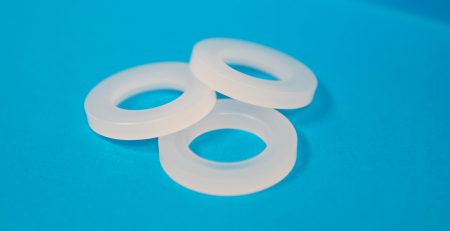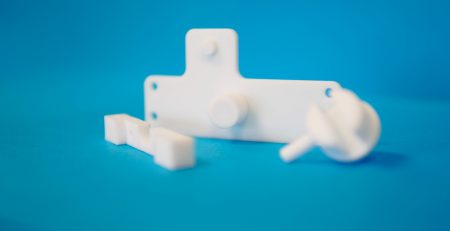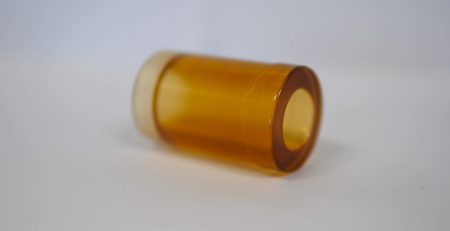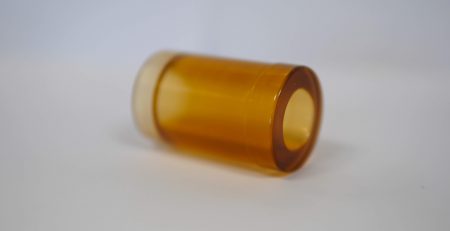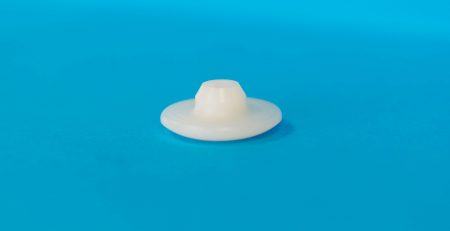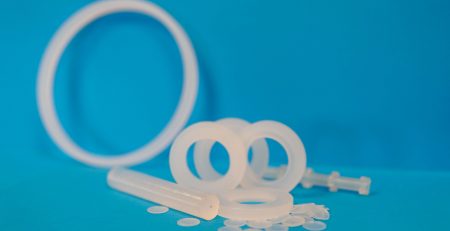Chemische Verträglichkeit PCTFE
Chemische Verträglichkeit PCTFE
PCTFE ist ein Homopolymer von Chlortrifluorethylen (CTFE), das als Kel-F, Voltalef oder Aclar vermarktet wird. Es unterscheidet sich von PTFE durch die Hinzufügung eines Chloratoms zu seiner chemischen Struktur, was ihm einen relativ niedrigen Schmelzpunkt im Vergleich zu anderen Fluorpolymeren verleiht. Dieser Kunststoff ist besonders beliebt wegen seiner physikalischen und mechanischen Eigenschaften in Verbindung mit seiner Beständigkeit gegen Hitze, kryogene Temperaturen und elektrischen Eigenschaften. Seine chemische Stabilität ist auch eine der am meisten geschätzten Eigenschaften von PCTFE, da es eine gute Gas- und Feuchtigkeitsundurchlässigkeit bietet.
PCTFE ist ein Hochleistungswerkstoff, der sehr oxidationsbeständig ist. Da er keine Wasserstoffatome enthält, besitzt dieser Kunststoff eine hohe chemische Beständigkeit gegenüber bestimmten chemischen Komponenten und Oxidationsmitteln. Insbesondere hat es eine ausgezeichnete (Klasse A) bis gute (Klasse B) Verträglichkeit mit bestimmten Acetaten, Alkoholen, Sulfaten und Säuren. Es wird jedoch nicht empfohlen, es Äthern und Halogenkohlenwasserstoffen auszusetzen, die seine Verschlechterung verursachen.
PCTFE ist ein kristallines Polymer mit ausgezeichneter Zug- und Kriechfestigkeit. Es ist steifer und fester als PTFE und hat eine gute Entflammbarkeitsbeständigkeit und wird häufig in der Industrie und in der Luft- und Raumfahrt eingesetzt. Bei SPN haben Sie Zugang zu verschiedenen PCTFE-Halbfertigprodukten in Stangen-, Platten- oder Rohrform. Dank seiner Undurchlässigkeit kann dieses Material auch bei der Herstellung von Dichtungen und anderen bearbeiteten Teilen verwendet werden.
Die nachstehende Tabelle fasst die chemische Verträglichkeit von PCTFE gemäß ISO 11114-2:2013(F) zusammen: “Gasflaschen – Verträglichkeit von Flaschen- und Ventilwerkstoffen mit dem Gasinhalt”:
| N° ONU | Nom | PCTFE | Commentaire |
| 98 (2035) | TRIFLUORO-1,1,1 ETHANE | Acceptable Swelling | |
| 39 (1030) | DIFLUORO-1,1-ETHANE | Acceptable Swelling | |
| 40 (1959) | DIFLUORO-1,1-ETHYLENE | Acceptable Swelling | |
| 97 (3082) | TRICHLORO-2 TRIFLUORO-1,2,2 ÉTHANE | Acceptable Swelling | |
| 36 (1958) | DICHLORO-1,2 TÉTRAFLUORO-1,1,2,2 ÉTHANE | Acceptable Swelling | |
| 38 (2517) | DIFLUORO(1,1)-1- CHLOROÉTHANE | Acceptable Swelling | |
| 24 (1021) | CHLORO-1 TÉTRAFLUORO-1,2,2,2 ÉTHANE | Acceptable | |
| 113 (3161) | DIFLUORO(1,2)-1- CHLOROÉTHANE | Acceptable | |
| 25 (1983) | CHLORO-1 TRIFLUORO- 2,2,2 ÉTHANE | Acceptable Swelling | |
| 117 (2044 | 2,2-DIMETHYLPROPANE | Acceptable | |
| 1 (1001) | ACÉTYLÈNE | Acceptable | Certains matériaux ne sont pas compatibles en raison du solvant utilisé |
| 105 (1002) | AIR | Acceptable Inflammable | À haute pression, risque de réaction violente due à l’oxygène. |
| 2 (1005) | AMMONIAC | Acceptable | |
| 3 (1006) | ARGON | Acceptable | |
| 4 (2188) | ARSINE | Acceptable | |
| 5 (1741) | TRICHLORURE DE BORE | Acceptable | |
| 6 (1008) | TRIFLUORURE DE BORE | Acceptable | |
| 9 (2419) | BROMOTRIFLUOROETHY- LÈNE | Acceptable Swelling | |
| 8 (1009) | BROMOTRIFLUOROME- THANE | Acceptable Swelling | |
| 10 (1010) | BUTADIENES | Acceptable | |
| 12 (1011) | BUTANE | Acceptable | |
| 13 (1012) | BUTYLENE | Acceptable | |
| 16 (1013) | DIOXYDE DE CARBONE | Acceptable | |
| 17 (1016) | MONOXYDE DE CARBONE | Acceptable | |
| 109 (2417) | FLUORURE DE CARBONYLE | Acceptable | |
| 19 (2204) | SULFURE DE CARBONYLE | Acceptable | |
| 20 (1017) | CHLORE | Acceptable | Avertissement: il existe un risque de réactions violentes |
| 110 (1589) | CHLORURE DE CYANOGÈNE | Acceptable | |
| 111 (2548) | PENTAFLUORURE DE CHLORE | Acceptable | |
| 112 (1749) | TRIFLUORURE DE CHLORE | Acceptable | |
| 7 (1974) | BROMOCHLORODI- FLUOROMÉTHANE | Acceptable Swelling | |
| 21 (1018) | CHLORODIFLUOROMÉ- THANE | Acceptable Swelling | |
| 23 (1020) | CHLOROPENTAFLUOROÉ- THANE | Acceptable Swelling | |
| 27 (1022) | CHLOROTRIFLUOROMÉ- THANE | Acceptable Swelling | |
| 37 (1026) | CYANOGÈNE | Acceptable | |
| 28 (1027) | CYCLOPROPANE | Acceptable | |
| 29 (1957) | DEUTÉRIUM | Acceptable | |
| 32 (1911) | DIBORANE | Acceptable | |
| 30 (1941) | DIBROMODIFLUOROMÉ- THANE | Acceptable Swelling | |
| 31 (N° ONU non assigné) | DIBROMOTÉTRA- FLUOROÉTHANE | Acceptable Swelling | |
| 33 (1028) | DICHLORODIFLUOROMÉ- THANE | Acceptable Swelling | |
| 34 (1029) | DICHLOROFLUOROMÉ- THANE | Acceptable Swelling | |
| 35 (2189) | DICHLOROSILANE | Acceptable | |
| 41 (1032) | DIMÉTHYLAMINE | Acceptable | |
| 42 (1033) | ÉTHER DIMÉTHYLIQUE | Acceptable | |
| 118 (3161) | DIMÉTHYLSILANE | Acceptable | |
| 76 (1067) | TÉTROXYDE DE DIAZOTE (DIOXYDE D’AZOTE) 3) | Acceptable | Avertissement: il existe un risque de réactions violentes. |
| 43 (3161) | DISILANE | Acceptable | |
| 44 (1035) | ÉTHANE | Acceptable | |
| 46 (1037) | CHLORURE D’ÉTHYLE | Acceptable Swelling | |
| 50 (2453) | FLUORURE D’ÉTHYLE | Acceptable Swelling | |
| 121 (1039) | MÉTHOXYÉTHANE | Acceptable | |
| 120 (2452) | ÉTHYLACÉTYLÈNE | Acceptable | |
| 45 (1036) | ÉTHYLAMINE | Acceptable | |
| 47 (1962) | ÉTHYLÈNE | Acceptable | |
| 48 (1040) | OXYDE D’ÉTHYLÈNE | Acceptable | |
| 53 (2192) | GERMANE | Acceptable | |
| 54 (1046) | HÉLIUM | Acceptable | |
| 122 (3296) | HEPTAFLUOROPROPANE | Acceptable | |
| 123 (2420) | HEXAFLUOROACÉTONE | Acceptable | |
| 56 (1858) | HEXAFLUOROPROPY- LÈNE | Acceptable Swelling | |
| 57 (1049) | HYDROGÈNE | Acceptable | |
| 58 (1048) | BROMURE D’HYDROGÈNE | Acceptable | |
| 59 (1050) | CHLORURE D’HYDROGÈNE | Acceptable | |
| 60 (1051) | CYANURE D’HYDROGÈNE | Acceptable | |
| 61 (1052) | FLUORURE D’HYDROGÈNE | Acceptable | |
| 62 (2197) | IODURE D’HYDROGÈNE | Acceptable | |
| 124 (2202) | SÉLÉNURE D’HYDROGÈNE | Acceptable | |
| 63 (1053) | SULFURE D’HYDROGÈNE | Acceptable | |
| 64 (1969) | ISOBUTANE | Acceptable | |
| 65 (1055) | ISOBUTYLÈNE | Acceptable | |
| 66 (1056) | KRYPTON | Acceptable | |
| 67 (1971) | MÉTHANE | Acceptable | |
| 69 (1062) | BROMURE DE MÉTHYLE | Acceptable | |
| 51 (2454) | FLUORURE DE MÉTHYLE | Acceptable Swelling | |
| 70 (1064) | MERCAPTAN DE MÉTHYLE | Acceptable | |
| 126 (2455) | NITRITE DE MÉTHYLE | Acceptable | |
| 68 (3161) | MÉTHYLACÉTYLÈNE | Acceptable | |
| 72 (1061) | MÉTHYLAMINE | Acceptable | |
| 22 (1063) | CHLORURE DE MÉTHYLE | Acceptable | |
| 125 (2534) | MÉTHYLCHLOROSILANE | Acceptable | |
| 71 (3161) | MÉTHYLSILANE | Acceptable | |
| 73 (1065) | NÉON | Acceptable | |
| 75 (1066) | AZOTE | Acceptable | |
| 78 (2451) | TRIFLUORURE D’AZOTE | Acceptable | Avertissement: Il existe un risque de réactions violentes |
| 119 (2421) | TRIOXYDE D’AZOTE | Acceptable | Avertissement: Il existe un risque de réactions violentes |
| 77 (1070) | HÉMIOXYDE D’AZOTE | Acceptable | Avertissement: Il existe un risque de réactions violentes |
| 81 (2424) | OCTAFLUORO PROPANE | Acceptable Swelling | |
| 79 (2422) | OCTAFLUOROBUTÈNE-2 | Acceptable Swelling | |
| 80 (1976) | OCTAFLUORO- CYCLOBUTANE | Acceptable Swelling | |
| 82 (1072) | OXYGÈNE | Oxygen compatibility BAM (gas). | Avertissement: Il existe un risque de réactions violentes |
| 127 (3220) | PENTAFLUOROÉTHANE | Acceptable | |
| 128 (3083) | FLUORURE DE PERCHLORYLE | Acceptable | |
| 129 (3154) | PERFLUORO (ÉTHYL VINYL ÉTHER) | Acceptable | |
| 130 (3153) | PERFLUORO (MÉTHYL VINYL ÉTHER) | Acceptable | |
| 83 (1076) | PHOSGÈNE | Acceptable | |
| 84 (2199) | PHOSPHINE | Acceptable | |
| 131 (2198) | PENTAFLUORURE DE PHOSPHORE | Acceptable | |
| 86 (2200) | PROPADIENE | Acceptable | |
| 85 (1978) | PROPANE | Acceptable | |
| 87 (1077) | PROPYLENE | Acceptable | |
| 88 (1280) | OXYDE DE PROPYLENE | Acceptable | |
| 132 (2194) | HEXAFLUORURE DE SÉLÉNIUM | Acceptable | |
| 89 (2203) | SILANE | Acceptable | |
| 90 (1818) | TETRACHLORURE DE SILICIUM | Acceptable | |
| 91 (1859) | TETRAFLUORURE DE SILICIUM | Acceptable | |
| 106 (2676 | STIBINE | Acceptable | |
| 133 (2191) | FLUORURE DE SULFURYLE | Acceptable | |
| 92 (1079) | DIOXYDE DE SOUFRE | Acceptable | |
| 93 (1080) | HEXAFLUORURE DE SOUFRE | Acceptable | |
| 94 (2418) | TETRAFLUORURE DE SOUFRE | Acceptable | |
| 134 (2195) | HEXAFLUORURE DE TELLURE | Acceptable | |
| 95 (1081) | TETRAFLUOROETHYLENE | Acceptable | |
| 96 (1295) | TRICHLOROSILANE | Acceptable | |
| 100 (2196) | HEXAFLUORURE DE TUNGSTÈNE | Acceptable | |
| 101 (1085 | BROMUREDEVINYLE | Acceptable Swelling | |
| 102 (1086 | CHLORUREDEVINYLE | Acceptable Swelling | |
| 103 (1860 | FLUORUREDEVINYLE | Acceptable Swelling | |
| 135 (1087 | VINYLEMETHYLEETHER | Acceptable | |
| 104 (2036 | XENON | Acceptable |



